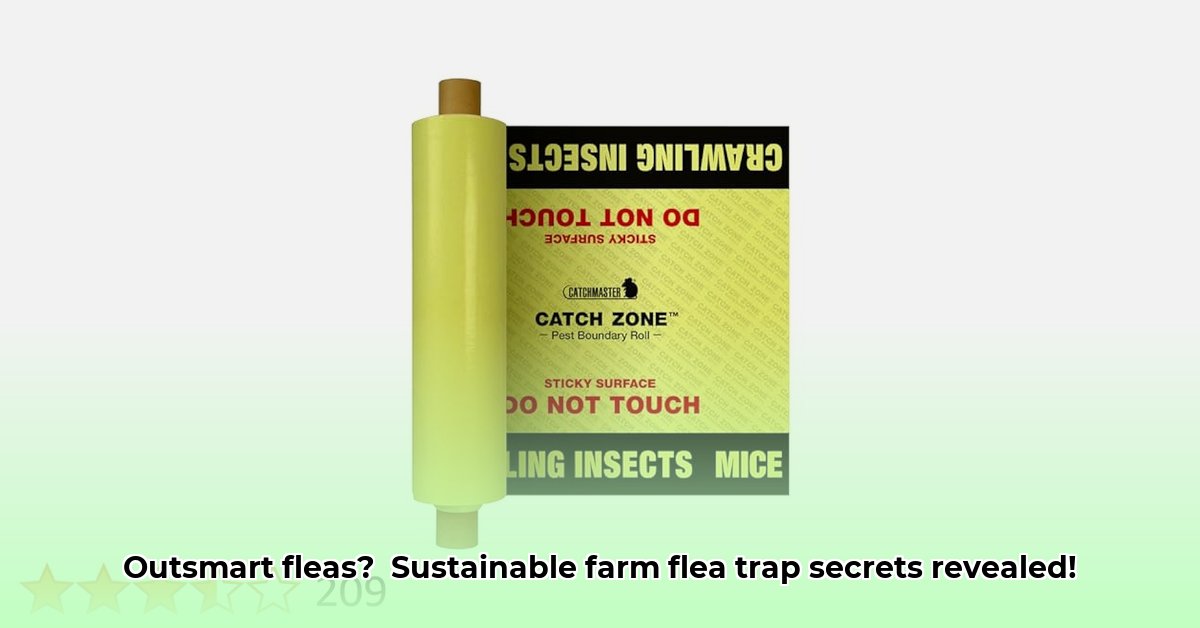
Flea Traps Tractor Supply: Your Guide to Sustainable Farm Pest Control
Dealing with fleas on your farm is frustrating, impacting animal welfare and potentially your bottom line. Fortunately, effective flea control doesn't require harsh chemicals. This guide details how to manage fleas sustainably using products available at Tractor Supply. For even more pest control options, check out our guide on hog traps.
Choosing the Right Flea Trap from Tractor Supply
Tractor Supply offers various flea traps, ranging from simple sticky traps to more advanced models. The optimal choice depends on the infestation's severity and your specific needs.
Sticky traps represent the most affordable and user-friendly option. Ideal for smaller infestations or monitoring flea populations, they're essentially low-tech scouts. However, they only target adult fleas, leaving eggs and larvae to continue reproducing. Therefore, are they truly effective long-term solutions? Further research is needed here to assess their comprehensive impact.
More sophisticated traps, sometimes using pheromones (flea attractants) or vacuum systems, provide broader control. While the upfront cost is higher, they often prove more cost-effective in the long run due to superior control. These traps typically capture larger numbers of fleas, including younger stages.
Before your Tractor Supply visit, consider these factors:
- Trap Type: Sticky traps, vacuum systems, or pheromone-based traps each offer unique advantages and disadvantages.
- Size: Determine the area requiring coverage; large farms may need multiple traps.
- Cost: Balance initial cost with long-term savings; cost-effectiveness varies greatly by approach.
- Ease of Use: Select traps easily set up and maintained, considering your available time.
Here's a comparison chart to aid your decision:
| Trap Type | Pros | Cons | Best For |
|---|---|---|---|
| Sticky Traps | Low cost, easy to use, good for small infestations or monitoring. | Only catches adult fleas; frequent replacement needed. | Small infestations, monitoring flea populations |
| Vacuum-based Traps | Efficiently removes many fleas, including larvae and eggs. | Higher initial cost; requires regular emptying and cleaning. | Moderate to large infestations |
| Pheromone-based Traps | Attracts fleas over a larger area; potentially targets more fleas. | More expensive; effectiveness varies based on the pheromone used. | Large areas, persistent infestations |
Integrating Flea Traps into Your Sustainable Farming Practices
Sustainable farming emphasizes Integrated Pest Management (IPM). IPM prioritizes prevention and minimizes pesticide use. Flea traps align perfectly with this approach.
Here's a step-by-step plan for effective flea trap use:
- Assess the Infestation: Determine the infestation's severity to select the appropriate trap type.
- Trap Selection: Choose a trap based on your needs and budget. Research Tractor Supply's offerings.
- Strategic Placement: Place traps in areas where fleas congregate (animal bedding, resting areas).
- Consistent Monitoring: Regularly check traps to track progress and detect changes in flea activity. How often should you check? A once-a-week check is recommended, but more frequent monitoring may be needed depending on the severity of your flea problem.
- Combined Approach: Combine traps with eco-friendly methods (animal grooming, improved sanitation).
- Adapt and Refine: If your strategy proves insufficient, adjust trap placement or overall approach.
Beyond the Trap: A Holistic Approach to Flea Control
Flea traps are only one component of a comprehensive strategy. A truly sustainable approach requires a multifaceted control plan:
- Regular Grooming: Brushing animals removes adult fleas.
- Enhanced Sanitation: Regularly clean bedding, animal areas, and surfaces where fleas might thrive. This reduces breeding grounds. Can you give an example of a cleaning schedule that would be effective for a small farm? A potential schedule could include weekly cleaning of bedding and monthly deep cleaning of animal living areas.
- Natural Repellents: Explore natural repellents (cedar oil, diatomaceous earth). Always follow instructions carefully. Note that effectiveness varies; ongoing research continues to explore their full potential. What research is being done on the efficacy of natural repellents? Studies are currently underway that are examining the active compounds and optimal application methods for maximizing the efficacy of natural flea repellents.
By combining Tractor Supply flea traps with these sustainable practices, you'll create a robust flea management strategy, protecting your animals and the environment. Experimentation may be needed to find the best approach for your specific farm. Remember, a pest-free and sustainable farm is attainable with consistent effort and adaptation.